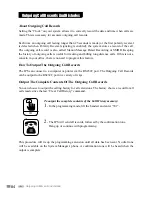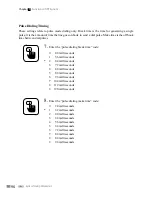
87
There are two commands which can be sent by the computer to the IPS, each command consisting
of two ASCII characters. The characters ‘%’, then ‘d’ cause the IPS to output the complete contents
of Call History memory. The characters ‘%’, then ‘E’ cause the IPS to output the complete contents
of Call History memory after which the Call History memory is cleared. The second character
‘d’ or the ‘E’ must be sent within 120 milliseconds of the
fi
rst character (‘%’) for the command
to be recognized.
Please note that this feature is not available in the Computer Aided Telephony (CAT) version of
the IPS software.
Formats For The Call History Records
Records of outgoing calls can be output in either a long format or a short format. The long
format is an easy-to-read log. For each call, it shows in table format the line number, extension
number, date and time, number dialed, duration of call, and the number of metering pulses. The
short format organizes the same data in a comma delimited format, so that it can be ready by call
accounting software packages. The records will be output in short format unless you switch to
the long format.
To enable the long format for Call History record output:
In the programming mode, lift the handset and enter “7815”.
Pause for the con
fi
rmation tone. Hang up or continue with programming.
To enable the short format for Call History record output:
In the programming mode, lift the handset and enter “7814”.
Pause for the con
fi
rmation tone. Hang up or continue with programming.
7815
7814
An example of one line of the short format is shown below. The long format contains the same
information separated by spaces.
Outside Line number
Extension number
Number Dialed
Number Of Metering Pluses
Date, Month, Year
Time (Hours, Minutes) Duration Of Call: Hours, Minutes, Seconds
1, 05, 15, JUL, 95, 14, 10, 5551212, 00, 04, 21, 0
Outgoing Call Records And Histories
Chapter
3
- Functions Of IPS System
















































